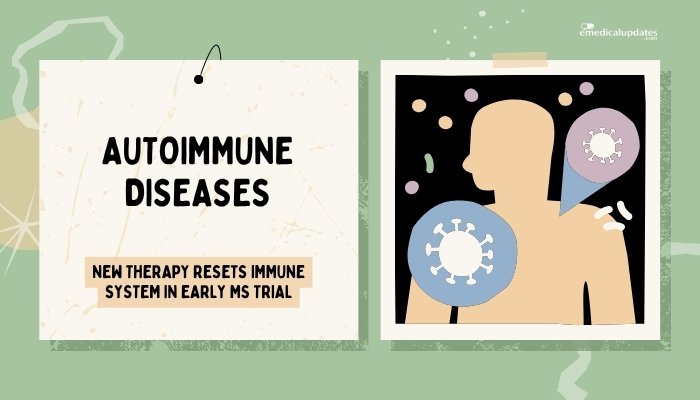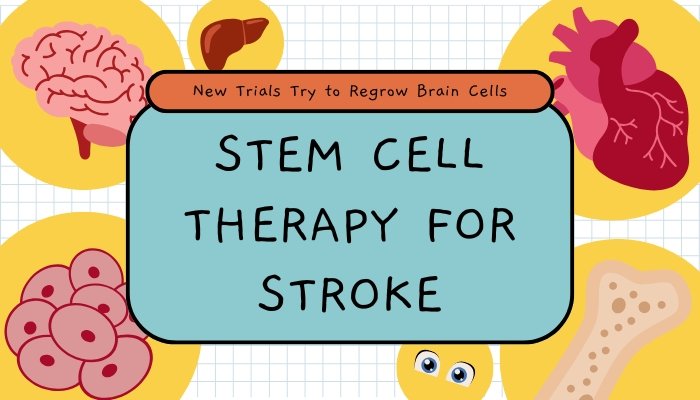Introduction
Multiple sclerosis (MS) is a chronic autoimmune disease in which the immune system mistakenly attacks the protective myelin sheath covering nerve fibers, causing symptoms like fatigue, numbness, and mobility issues. While current MS treatments aim to dampen inflammation, none fully reset the immune system to stop the underlying misfire.
But a new therapy in early clinical trials does exactly that: reboots the immune cells responsible for causing lesions in MS, potentially halting progression. This article explores how this therapy works, the latest trial findings, and the impact it could have on MS care.
Understanding Multiple Sclerosis
Autoimmune Attack on Myelin
MS primarily affects:
- CNS Myelin Sheath: The protective layer around neurons, crucial for fast signal transmission.
- Lesions or Plaques: Damaged areas disrupt nerve conduction, leading to diverse neurological symptoms.
- Relapsing or Progressive Forms: Some patients experience episodic flare-ups, while others steadily deteriorate over time.
Conventional Treatments
- Immunomodulators: Such as interferons, glatiramer acetate, or newer biologics like natalizumab that limit immune cell infiltration.
- Immunosuppressants: Like ocrelizumab or rituximab, depleting specific immune cells.
- Steroids: Quell acute relapses but don’t address root autoimmune triggers.
Though these approaches slow disease activity, they typically demand ongoing administration and do not always prevent long-term disability.
The Immune Reset Concept
Rationale
In diseases like MS, the immune system incorrectly targets myelin. Rebooting immune function might:
- Purge Auto-Reactive Cells: Clearing memory T or B cells that drive attacks.
- Foster Tolerance: Encourage new immune cells that respect self-tissues.
Mechanisms
The therapy may combine:
- Lymphoablation: Temporarily wiping out existing immune cells, e.g., with chemotherapy-like regimens.
- Reintroduction of Stem Cells or Tolerant Immune Cells: Rebuilding a new immune repertoire from scratch.
- Targeted Gene Editing or Immune Engineering: Potentially removing disease-causing clones while sparing healthy immunity.
The New Therapy in Early MS Trial
Trial Design
Participants with early, aggressive MS:
- Received a short course of intense immunosuppression.
- Had bone marrow–derived stem cells or specially engineered immune cells reinfused.
- Were observed for disease progression, relapse frequency, and MRI lesion changes.
Key Results
- Reduction in Relapses: Many patients had fewer or no new neurological episodes after the therapy.
- Stable or Improved MRI Scans: Fewer active lesions, sometimes even partial lesion healing.
- Durable Effect: Some remained relapse-free for years without ongoing immunosuppressives.
Side Effects and Safety
- Short-Term Risks: Chemotherapy can cause infections, low blood counts, or organ stress.
- Long-Term Outlook: So far, no major autoimmune rebounds. Nevertheless, it’s a small pilot, requiring more extensive follow-up.
Advantages Over Current Approaches
- Potential One-Time Reset: If successful, patients might not need lifelong disease-modifying drugs.
- Reduced Cost and Burden: Long-term, a single or limited therapy might replace repeated infusions or daily injectables.
- Better Neurological Preservation: By preventing further demyelination or nerve damage, patients can maintain function longer.
Challenges and Unanswered Questions
Risk/Benefit Analysis
Lymphoablation is not trivial; severe immunosuppression leads to infection vulnerability, hospital stays, and support costs. Balancing these with MS’s progressive disability risk is crucial.
Scalability
Scaling complex procedures to broader populations depends on specialized facilities, skilled staff, and robust patient follow-up for years.
Long-Term Efficacy
Trial durations of a few years might not capture potential latent recurrences or novel immunological complications. Larger, multi-center Phase III studies are essential.
The Future of Immune Reset Therapies
Combining with Novel Agents
Researchers may pair immune resets with T-cell or B-cell targeted therapies, or use advanced gene editing (CRISPR) to remove autoreactive clones, refining the concept of a “personalized cure.”
Extending to Other Autoimmune Diseases
If this approach effectively halts MS, similar protocols could address lupus, type 1 diabetes, or rheumatoid arthritis—any condition driven by destructive autoimmunity.
Balancing Accessibility
Ensuring that radical new therapies remain accessible and covered by insurance is a key policy debate—particularly since these treatments may be expensive initially, but could reduce long-term care costs.
Frequently Asked Questions
- Is this therapy a one-time cure for MS?
- Some patients see sustained benefits after one regimen, but “cure” is not yet guaranteed. More trials confirm how often retreatment, if any, is needed.
- Does this therapy carry life-threatening risks?
- Like high-dose chemotherapy, it can be risky. Patients need close medical supervision and prophylaxis to avoid severe infections.
- Could it help progressive MS patients?
- The current trial focuses on early or relapsing forms. Future research might expand to progressive forms, though success is uncertain.
- Is it commercially available now?
- Not widely. This technique remains in clinical trial phases, and widespread adoption awaits final efficacy and safety data.
- What about other standard MS meds after the therapy?
- Some remain medication-free if the therapy is successful; others might continue or resume mild immunomodulators for added safety.
Conclusion
A cutting-edge immune reset therapy for multiple sclerosis is showing promising initial results, effectively stopping or reducing relapses in a small group of patients with early, aggressive disease. By aggressively depleting the faulty immune system and reconstituting it with healthy cells, the therapy aims to break the cycle of demyelination that characterizes MS. While it requires further trials to confirm long-term safety, durability, and cost feasibility, this approach could be a pivotal leap toward an enduring remission or functional “cure” for some. As more robust data emerges, patients seeking more definitive solutions beyond daily or monthly immunomodulatory drugs may look to this therapy as a ray of hope—and a potential glimpse into the future of autoimmune disease treatment.
References
-
Burt RK, et al. (2019). “Hematopoietic stem cell transplantation for multiple sclerosis.” JAMA Neurol.
-
Mancardi G, et al. (2020). “High-intensity immunosuppression and autologous haematopoietic stem cell transplantation in MS.” Lancet Neurol.
-
Cohen J, et al. (2021). “Immune reconstitution approaches to MS therapy.” Nat Rev Immunol.
-
Freedman MS. (2022). “HSCT for MS: The next wave in immunotherapy.” Mult Scler.






